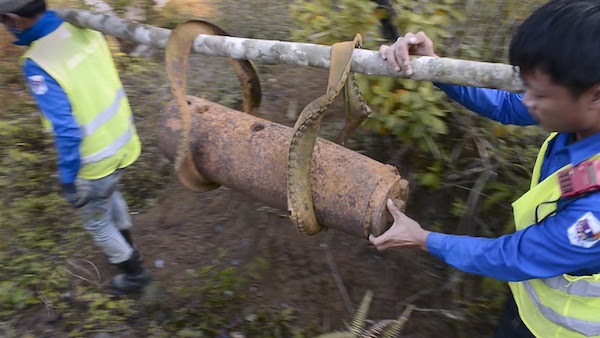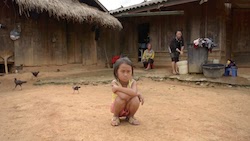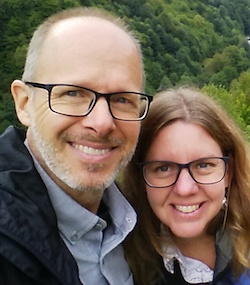SEJournal Online is the digital news magazine of the Society of Environmental Journalists. Learn more about SEJournal Online, including submission, subscription and advertising information.
 |
| A clearance team moves the remains of a 500-lb American bomb to a site for detonation. As many as 30% of bombs dropped on Laos during the Vietnam War failed to detonate. Photo: Jerry Redfern. |
FEJ StoryLog: Documentary Tells of Human, Environmental Toll of Unexploded Ordnance
By Jerry Redfern and Karen Coates
In 2017, 10-year-old la Yang walked past a pile of dirt at a construction site in her small northern Laos village and picked up what she thought was an abandoned toy. She brought it home to an extended family gathering where her relatives immediately yelled, “It’s a bomb!” But la Yang said, “No, it’s a toy!” and threw it on the ground to prove it.
That day in the family backyard, la Yang died and 12 of her relatives were wounded by a cluster bomblet dropped from an American plane over Laos before her parents were even born. A year later, her sister, Zua Pa, age 9, pointed out the pockmarks in her home, shrapnel buried deep in the wooden planks harvested from pine trees in the hilly forests around town. She pointed to deep scars across her belly that will always remind her of the day she lost her sister.
Talking with Zua Pa was the final, sadly serendipitous interview we did for our documentary film “Eternal Harvest.” The interview came on our last day in northern Laos, a day before we left the country after wrapping up shooting in 2018.
The project began a little more than two years earlier when we received a grant from the Society of Environmental Journalists’ Fund for Environmental Journalism, or FEJ, to tell this story of environmental fear seeded with American bombs. The grant helped us do the background work needed in 2016 to allow us to return in 2018 and finish the film.
During previous work in the region,
we often bumped into people
who were bumping into bombs
as they went about their lives.
We have known this story for years. During previous work in the region, we often bumped into people who were bumping into bombs as they went about their lives. That led to our book “Eternal Harvest: The Legacy of American Bombs in Laos,” published in 2013.
Between 1964 and 1973, the United States flew around 600,000 missions over this tiny Southeast Asian country, dropping bombs and firing cannons on pretty much anything that moved among the 2 million people living below. More bombs were dropped there than were dropped on Japan and Germany combined in World War II, and a stunning number of them — estimates range from 10% to 30% — failed to detonate.
Permanent environmental scar
Laos has always been an agrarian country. Those bombs killed unknown thousands of people in the 1970s and 1980s as they returned to villages and resumed farming in fields abandoned during the war.
Many unexploded bombs and other ordnance remain buried in the ground. While accident rates have slowed over the decades, 50- and 60-year-old American bombs still injure and kill people in rural Laos today, since 75% of the population still works in agriculture.
Much of the bombing happened in rural and wild areas, targeting the North Vietnamese Army as it sneaked through fields and jungles to fight in neighboring South Vietnam. Carpet bombing denuded and cratered the landscape, leading to “bombturbation,” a phenomenon that literally changes the landscape and what grows on it — a permanent environmental scar of war.
That seed of FEJ funding allowed us to get rolling on the film, and that in turn led to other, parallel stories on the same topic in Laos and farther afield.
Thoughtful, thorough technique yielded rewards
For better or worse, our storytelling technique is slow and involves figuring out a topic, then moving slowly through a landscape — be it personal or natural — until we understand what the story is and how to tell it. It’s not efficient, but it is thorough and leads to surprises like the interview with Zua Pa.
After some two dozen trips to Laos over the course of many years, we spent two months filming in 2016 and another two months in 2018, which gave us time to conduct interviews in far-flung corners of the country.
 |
| Nine-year-old Zua Pa of Laos in the spot where her 10-year-old sister la Yang threw an American cluster munition on the ground, killing the girl and wounding a dozen relatives. Photo: Jerry Redfern. |
We met dozens upon dozens of people who wanted to help us tell this story and shared their own accounts, with the hope that other Americans would hear them, too. During those trips, we did stories on everything from fish sauce to bomb clearance in northern Cambodia.
Postproduction took three years, as it had to be slotted in between other work.
This past year, “Eternal Harvest” has played at a dozen film festivals around the globe and has even garnered a few awards. It now is in the hands of Bullfrog Films, one of the country’s most respected distributors of documentary and educational films. We hope it will be publicly available before the end of the year.
Several college professors have also been in touch, wanting to use “Eternal Harvest” in their classes.
So it has taken a few years, but that bit of FEJ seed money paid for most of our travel expenses in 2016 and will be telling the story of bombs in Laos for years to come. It wasn’t the only grant we received, but it was the push that got the project rolling.
Advice for grant applicants
Over the years we have received a fair number of grants and learned a couple of lessons that work for us when applying.
Primary lesson: Follow the application directions and make sure what you’re proposing is something the group actually funds. Apply early. Then remember: Grant applications are not math problems — there are no right answers.
Applying for a grant is a crapshoot, and the more people who apply, the bigger the crapshoot. So don’t spend time and emotion you can’t afford to lose on grant applications.
[Editor’s Note: For more on Redfern’s and Coates’ work, see a brief account of their winning submission to an SEJ awards contest, as well as a review of their earlier book on the project and an interview with the couple.]
 |
Jerry Redfern is a reporter covering the intersection of the oil and gas industry, climate and politics in New Mexico for Capital & Main. He was a senior fellow at the Schuster Institute for Investigative Journalism at Brandeis University (until it closed in 2019), and a 2012-2013 Ted Scripps Fellow in Environmental Journalism at the Center for Environmental Journalism at the University of Colorado at Boulder. Before starting at Capital & Main, Redfern spent more than 20 years as a photojournalist, working mostly in Southeast Asia.
Karen Coates is the fellowship editor for the global conservation news outlet Mongabay.com, where she manages a new program for environmental journalists from tropical countries. Previously, she spent 20 years as an independent journalist, editor and media trainer with a focus on reporting about global issues of food, environment, health and human rights. Coates is also a contributing editor for Archaeology Magazine and the author of four books. She is a former Ted Scripps Fellow in Environmental Journalism, an International Women’s Media Foundation fellow and grantee, and a finalist for a James Beard Award in investigative reporting.
* From the weekly news magazine SEJournal Online, Vol. 7, No. 39. Content from each new issue of SEJournal Online is available to the public via the SEJournal Online main page. Subscribe to the e-newsletter here. And see past issues of the SEJournal archived here.













 Advertisement
Advertisement 



